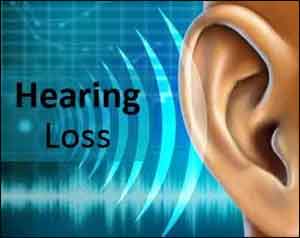- Home
- Editorial
- News
- Practice Guidelines
- Anesthesiology Guidelines
- Cancer Guidelines
- Cardiac Sciences Guidelines
- Critical Care Guidelines
- Dentistry Guidelines
- Dermatology Guidelines
- Diabetes and Endo Guidelines
- Diagnostics Guidelines
- ENT Guidelines
- Featured Practice Guidelines
- Gastroenterology Guidelines
- Geriatrics Guidelines
- Medicine Guidelines
- Nephrology Guidelines
- Neurosciences Guidelines
- Obs and Gynae Guidelines
- Ophthalmology Guidelines
- Orthopaedics Guidelines
- Paediatrics Guidelines
- Psychiatry Guidelines
- Pulmonology Guidelines
- Radiology Guidelines
- Surgery Guidelines
- Urology Guidelines
Study indicate towards new therapy for hearing loss

Loss of cochlear hair cells leads to permanent hearing deficits, and once lost, the cells are not regenerated. In a new study, published in the European Journal of Neuroscience, scientists were able to regrow the sensory hair cells found in the cochlea. The study may become a new approach to restore the hearing loss.
Patricia White, research associate professor in the University of Rochester Medical Center (URMC) Del Monte Institute for Neuroscience, and colleagues hypothesized that signaling from the epidermal growth factor receptor (EGFR) family may play a role in cochlear regeneration. The researchers focused on a specific receptor called ERBB2 which is found in cochlear support cells.
The cochlea is a part of the inner ear that is responsible for converting sound vibrations into electrical signals. It can be permanently lost due to noise damage or age.
Hearing impairment has long been accepted as a fact of life for the aging population. However, scientists have long observed that other animals -- namely birds, frogs, and fish -- have been shown to have the ability to regenerate lost sensory hair cells.
Also Read: Short course of steroids prevents hearing loss in kids due to otitis media
"It's funny, but mammals are the oddballs in the animal kingdom when it comes to cochlear regeneration," said Dr. Jingyuan Zhang, University of Rochester Department of Biology. "We're the only vertebrates that can't do it."
For the study, the researchers identified a family of receptors -- called epidermal growth factor (EGF) -- responsible for activating support cells in the auditory organs of birds. When triggered, these cells proliferate and foster the generation of new sensory hair cells. They speculated that this signaling pathway could potentially be manipulated to produce a similar result in mammals.
"In mice, the cochlea expresses EGF receptors throughout the animal's life, but they apparently never drive the regeneration of hair cells," said White. "Perhaps during mammalian evolution, there have been changes in the expression of intracellular regulators of EGF receptor family signaling. Those regulators could have altered the outcome of signaling, blocking regeneration. Our research is focused on finding a way switch the pathway temporarily, in order to promote both regeneration of hair cells and their integration with nerve cells, both of which are critical for hearing."
The researchers investigated a number of different methods to activate the EGF signaling pathway. One set of experiments involved using a virus to target ERBB2 receptors. Another, involved mice genetically modified to overexpress an activated ERBB2. A third experiment involved testing two drugs, originally developed to stimulate stem cell activity in the eyes and pancreas, that are known to activate ERBB2 signaling.
Also Read: Music through headphones linked to hearing loss in kids
Key Findings:
- Activation of the ERBB2 pathway triggered a cascading series of cellular events by which cochlear support cells began to proliferate and start the process of activating other neighboring stem cells to become new sensory hair cells.
- The process not only impacted the regeneration of sensory hair cells but also support their integration with nerve cells.
"The process of repairing hearing is a complex problem and requires a series of cellular events," said White. "You have to regenerate sensory hair cells and these cells have to function properly and connect with the necessary network of neurons. This research demonstrates a signaling pathway that can be activated by different methods and could represent a new approach to cochlear regeneration and, ultimately, restoration of hearing."
"Our data suggest that signaling from the receptor tyrosine kinase ERBB2 can drive the activation of secondary signaling pathways to regulate regeneration, suggesting a new model where an interplay of cell signaling regulates regeneration by endogenous stem‐like cells," concluded the authors.
For further reference log on to https://doi.org/10.1111/ejn.14183

Disclaimer: This site is primarily intended for healthcare professionals. Any content/information on this website does not replace the advice of medical and/or health professionals and should not be construed as medical/diagnostic advice/endorsement or prescription. Use of this site is subject to our terms of use, privacy policy, advertisement policy. © 2020 Minerva Medical Treatment Pvt Ltd